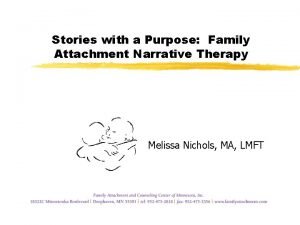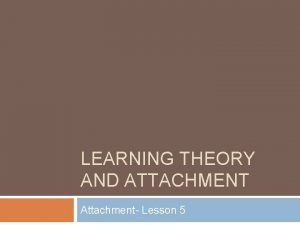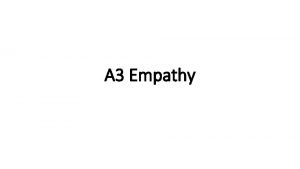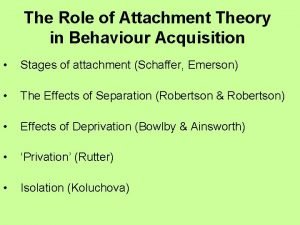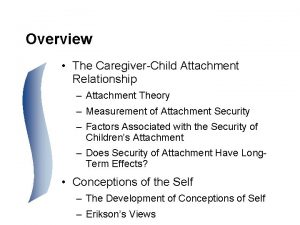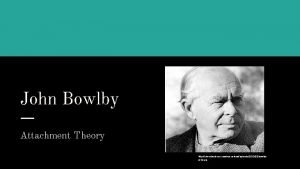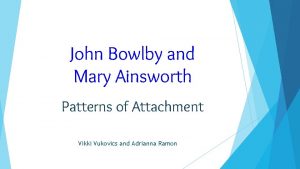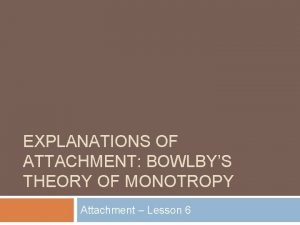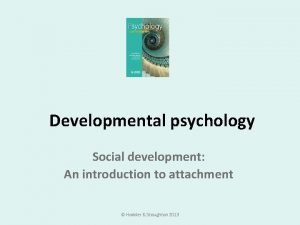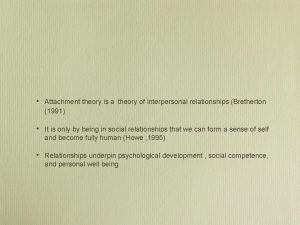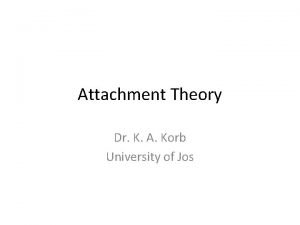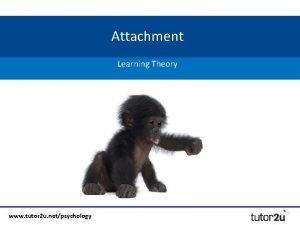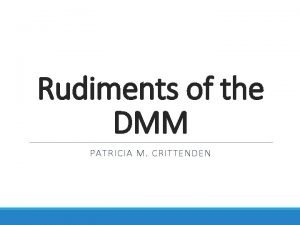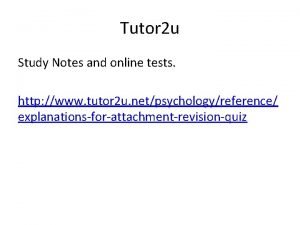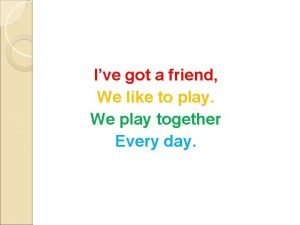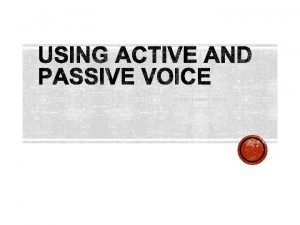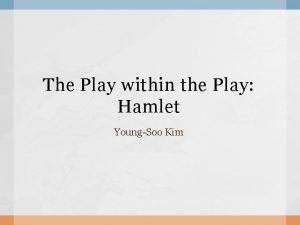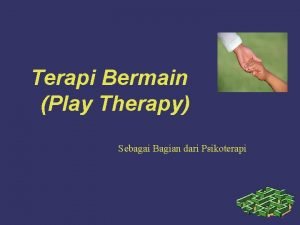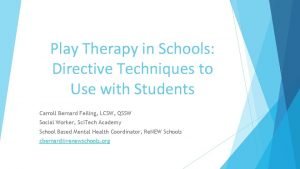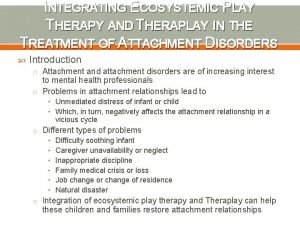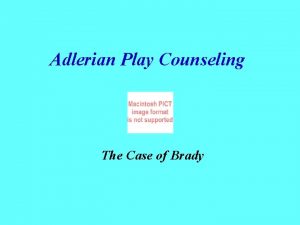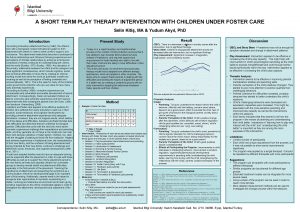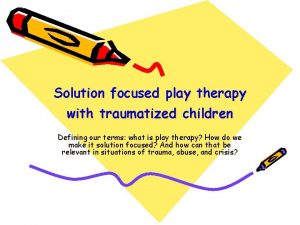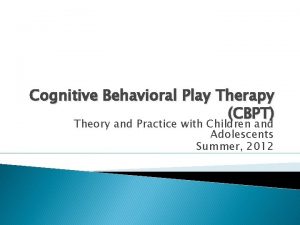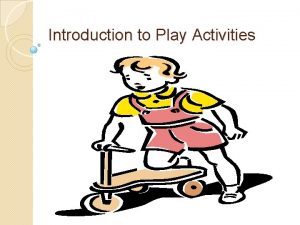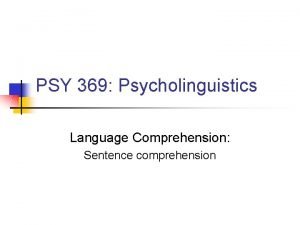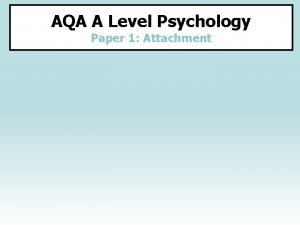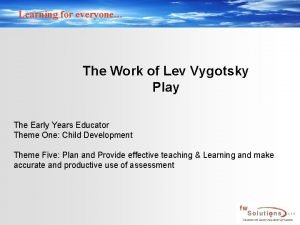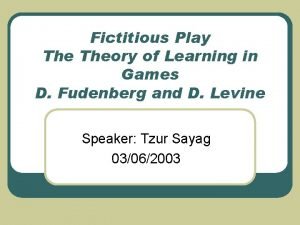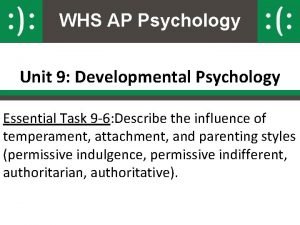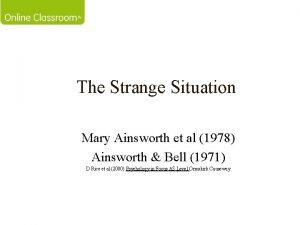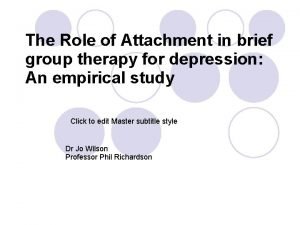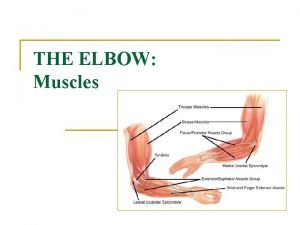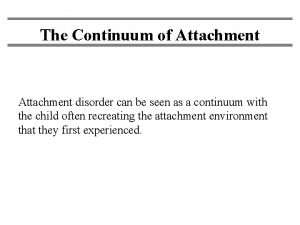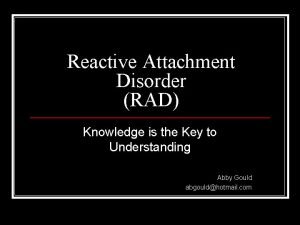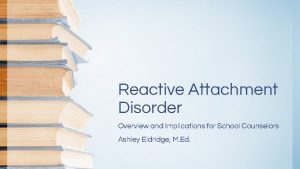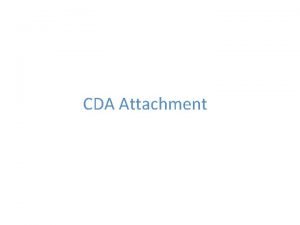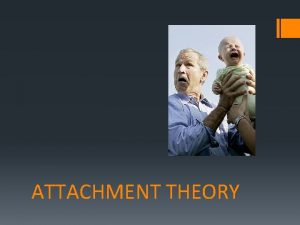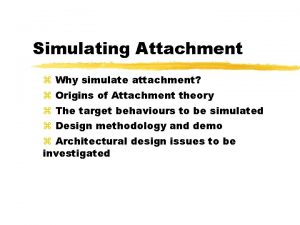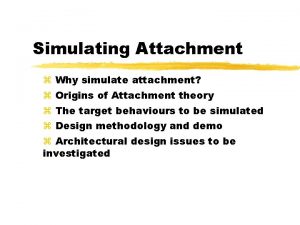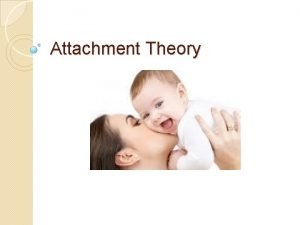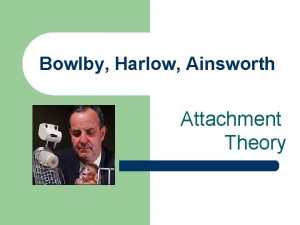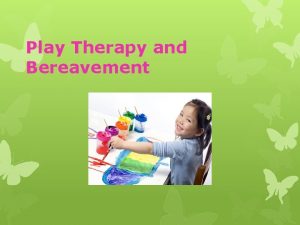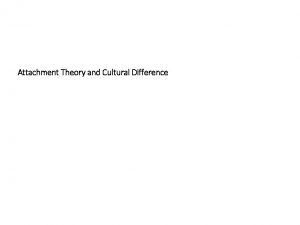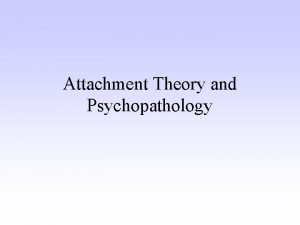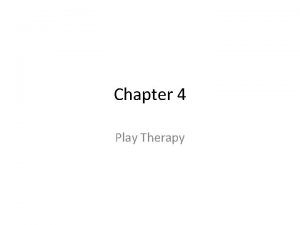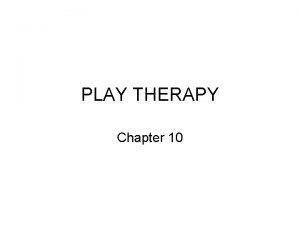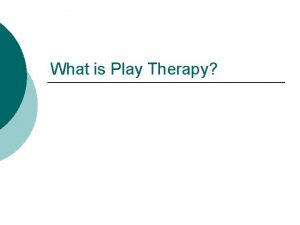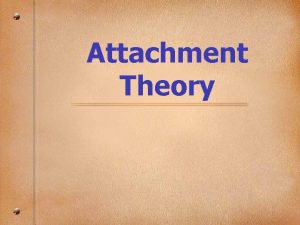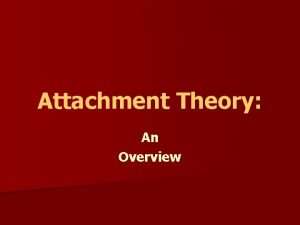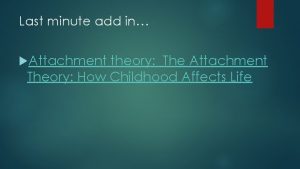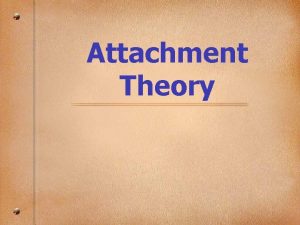Attachment Theory and Therapy in a Play Therapy















































- Slides: 47

Attachment Theory and Therapy in a Play Therapy Setting Theresa Fraser CYW, M. A. , CPT-S, RP Trauma and Loss Clinical Specialist

Please tape your baby photo to the white board then later you will….

Overview This course will review attachment theory and will introduce students to various models for treating attachment disordered children through play therapy. The fundamentals will be reviewed of some of the more well known attachment treatments such as: “Dyadic Development Psychotherapy” (Parent/Child) “Floor time” (Parent/Child) “Watch, Wait and Wonder”(Parent/Child) “Modified Interaction Guidance”. (Parent/Child) “Theraplay”(Parent/child or just Child) “Nurtured Heart Approach”( Parent Child) “The Four S’s” (Parents only) Attachment theory and practice within the play therapy models is pivotal and integral to the healing of most children.

When you think of attachment what do you think of? Secure attachment? Anxious attachment? Disorganized attachment? Ambivalent attachment? Let’s do a quick QUIZ.

Let’s play Dress -Up • Let’s pick tools and play materials that help us get in touch with what it was like to be a teenager. Put them on. Let’s walk around the room. Imagine you are 15… • Engage with each other as if we are all teenagers. • What did you enjoy doing? • What were the issues that you were experiencing? • How did you interact with other teens? • How did you interact with authority figures?

• Let’s pick tools and play materials that help us get in touch with what it was like to be a child. Imagine you are 8… • What did you enjoy doing? What were the issues you were experiencing? • How did you interact with other children? • How did you interact with authority figures?

As an infant or toddler • What have you heard that your early life was like? • Do you suspect that adults were able to meet your needs as they occurred? • Were their people that would responsively interact with you? • Where you separated from significant attachment figures as a baby/toddler? • Did you experience any trauma as a baby/toddler?

Development • Why is it important to understand what “normal” development is? • Why is it important to understand what factors/experiences may impede “normal” development? • Are there standardized assessments we can use to assess developmental functioning?

Learning Outcomes: By the end of this workshop participants will be able to: 1) Define the symptoms of attachments disorders. 2) Describe the history of attachment theory. 3) Articulate some of the fundamentals underlying different play therapy and/or attachment treatment methods. 3) Demonstrate direct application to play therapy models of practice in treating attachment disorders. 4) Articulate how attachment intervention impacts brain physiology.

1920 Sigmund Freud” So long as we trace the development from its final outcome backwards, the chain of events appears continuous, and we feel we have gained an insight which is completely satisfactory or even exhaustive. But if we proceed in the reverse way, if we start from the premises inferred from the analysis and try to follow these up to the final results, then we no longer get the impression of an inevitable sequence of events which could not have otherwise been determined”. 1940 http: //www. psychology. sunysb. edu/attachment/online/inge_origins. pdf 1940 Blatz (U of T) – Security Theory “infants and young children need to develop a secure dependence on parents before launching out into unfamiliar situations”. “An Evaluation of Adjustment Based Upon the Concept of Security, ” Mary Salter Ainsworth 1952 Fairbain (1952) and Winnicott (1965) OBJECT RELATIONS THEORY 1932 1940 1948 Melanie Klein and Joan Riviere (Bowlby mentors) OBJECT RELATIONS THEORY. Bowlby “Through detailed examination of 44 cases, Bowlby was able to link their symptoms to histories of maternal deprivation and separation (INGE BRETHERTON )1992)”. . Robertson – Bowlby suggested that Movie : A 2 “He also suggested that year old goes to an inability to form deep hospital. relationships He worked at with others may result Anna Freud’s when the succession of Hampstead substitutes is too residential frequent”. nursery for homeless children as a Boilerman and had to take notes on Child Observations 1960 1964 Shaffer , Emerson Baby study 1969 Bowlby’s Attachment trilogy is published. . 1969 Strange Situation (Ainsworth & Wittig, History of Attachment Theory © Theresa Fraser – Cannot be copied without permission. .

Bowlby(1907 -1990) described Attachment as: a “lasting psychological connectedness between human beings(1969, p. 194)”. https: //www. youtube. com/watch? v=V AAm. Sqv 2 GV 8

Rudolph Schaffer and Peggy Emerson: Nurture • In 1964 studied 60 babies at monthly intervals for the first 18 months of life • The babies were all studied in their own home and a regular pattern was identified in the development of attachment. The babies were visited monthly for approximately one year, their interactions with their carers were observed, and carers were interviewed.

“One of the most marked features of the results reported so far is the existence of considerable individual differences at all points of the enquiry. Some infants were early in developing attachments, others late; some were intensely attached, others only minimally so; some focused on one attachment object, while others showed attachments to a wide range of individuals (Schaffer. , Emerson. 1964. pg. 43)”.

Schaffer, 1964. Pg. 31

“Strong attachments can clearly be formed to individuals who are available for comparatively limited periods as long as these individuals are prepared to interact pretty intensely with the infant on such occasions. When furthermore the most available person (generally the mother) does not show a great deal of responsiveness and is not prepared to interact much with the infants, the latter is more likely to search for another object towards whom he can direct his most intense attachment behaviour(Schaffer. , Emerson. 1964. pg 56)”.

Mary Ainsworth (1913 -1999) Mary Ainsworth- Strange Situation Test https: //www. youtube. com/watch? v=s 608 077 Nt. NI https: //www. youtube. com/watch? v=9 HG 05 AIl. H 6 Y Found different results than the 1964 study Sensitive Caregiving created a- Haven of SAFETY

Stages of attachment http: //www. integratedsociopsychology. net/infa nt_attachment_stages. html

Reactive Attachment Disorder Behaviors : “ In DSM-IV-TR, a disorder of infancy and early childhood characterized by disturbed or developmentally inappropriate patterns of social relating not resulting from mental retardation or pervasive developmental disorder. It is evidenced either by persistent failure to initiate or respond appropriately in social interactions (inhibited type) or by indiscriminate sociability without appropriate selective attachments(disinhibited type).

Continued… There must also be evidence of inadequate care (ignoring the child’s basic physical or emotional needs or frequent changes of primary caregivers)which is assumed to be responsible for the disturbed social relating. Also referred to as “attachment disorder”. APA dictionary of Psychology – Pg. 772


Harlow (1905 -1991) https: //www. youtube. com/watch? v=_O 60 TYAIg. C 4 “our earliest social environment (Harlow)”. These monkeys grew up and were: a) much more timid. b) They didn’t know how to act with other monkeys. c) They were easily bullied and wouldn’t stand up for themselves. d) They had difficulty with mating. e) The females were inadequate mothers. Griffin, G. A. , & Harlow, H. F. (1966).

“Research at the University of Wisconsin Primate Laboratory by Mason & Sponholz (1963) and Rowland (1964) has indicated that prolonged periods of total social isolation from birth onward retard the subsequent development of social behavior in rhesus monkeys. Mason and Sponholz found that total social isolation from birth until 16 months retards and limits the development of social behaviors. Rowland found that total social isolation for 1 year had devastating effects on social behaviors, while total social isolation from birth until 6 months produced a decrement that was not as severe as 1 year of isolation and appeared to be slightly ameliorated with long periods of social interaction (Griffin, Harlow, 1964, pg. 533)“.

Dr. Dan Siegal https: //www. youtube. com/watch? v=zovt. Rq 4 e 2 E 8 The making of Disorganized Attachment.

Attachment Theory and practice… within the play therapy models is pivotal and integral to the healing of most children. Why?

What do experiences have to do with brain development ? http: //www. ted. com/talks/vs_ramachandran_the_neu rons_that_shaped_civilization? language=en Art retrieved from: http: //betinaekman. dk/om-mig/til-klienten/

Bruce Perry

“Current neurobiological research is contributing to our understanding of how exposure to extreme trauma affects brain function and becomes critical to the continuing evolution of effective play therapy practice (Gaskill, 2010. p 19)”

Bruce Perry’s Research “Timing is everything. Bonding experiences lead to healthy attachments and healthy attachment capabilities when they are provided in the earliest years of life. There are critical periods during which bonding experiences must be present for the brain systems responsible for attachment to develop normally. These critical periods appear to be in the first year of life and are related to the capacity of the infant and caregiver to develop a positive interactive relationship”. www. childtraumaacademy. com https: //www. youtube. com/watch? v=u. Osg. Dke. H 52 o

www. childtraumaacademy. com “During the first three years of life, the human brain develops to 90 percent of adult size and puts in place the majority of systems and structures that will be responsible for all future emotional, behavioral, social and physiological functioning during the rest of life”. https: //www. youtube. com/watch? v=u. Osg Dke. H 52 o&list=PLi. YWy. Ig. Gw. OQGLpq. F 4 ty. F 8 d. Rj. A 2 Ju. U 3 q_t

Retrieved from: http: //grahamscharf. com/early-childhood-recommendedresources/

There are critical periods during which bonding experiences must be present for the brain systems responsible for attachment to develop normally. These critical periods appear to be in the first year of life and are related to the capacity of the infant and caregiver to develop a positive interactive relationship. Retrieved June 21, 2015 from: http: //www. examiner. com/article/help-habiba-mother-and-infant-separated-forbreastfeeding-madrid

Attunement Strategies • Become an observer: focus on non-verbal cues • Be sensitive to ever-changing rhythms and remain flexible as these change • Consistently provide a caring, supportive response to cues • Remember that persons are unique and so are their needs Retrieved May 2011 from: http: //www. childtraumaacademy. com/bonding_attachment/lesson 02/page 05. html

www. childtraumaacademy. com

Dan Hughes and PLACE Dyadic Developmental Psychotherapy • • • Playfulness Love Acceptance Empathy Curiosity http: //www. danielhughes. org/html/PLACE. html

Dan Hughes https: //www. youtube. com/watch? v=r. M 1 se. YXN 1 Nc “psychological hand holding” Face to face training available for further training

Floor Time For any age child, you do three things: • Follow your child’s lead, i. e. enter the child’s world and join in their emotional flow; • Challenge her to be creative and spontaneous; and • Expand the action and interaction to include all or most of her senses and motor skills as well as different emotions. Retrieved from: http: //www. stanleygreenspan. com/ Online courses available for further training

Modified Interactional Guidance Research http: //www. imhpromotion. ca/Portals/0/IMHP%20 PDFs/IMPRINT/32 IMPRepr int-Benoit. pdf More training available through: http: //www. casaservices. org/workshops-modified-interaction-guidance#MIG

Theraplay More training is available at www. theraplay. org.

This is a parent education and psychotherapy intervention developed by Glen Cooper, Kent Hoffman, Robert Marvin, and Bert Powell designed to shift problematic or 'at risk' patterns of attachment – caregiving interactions to a more appropriate developmental pathway. It is stated that it is explicitly based on contemporary attachment and congruent developmental theories. Its core constructs are Ainsworth’s ideas of a Secure Base and a Haven of Safety (Ainsworth et al. 1978). The aim of the protocol is to present these ideas to the parents in a user-friendly, common-sense fashion that they can understand both cognitively and emotionally. This is done by a graphic representation of the child's needs and attachment system in circle form, summarising the child's needs and the safe haven provided by the caregiver. The protocol has so far been aimed at and tested on preschoolers up to the age of 4 years.

The aim of the (Parent and child) therapy is to. . • • To increase the caregivers sensitivity and appropriate responsiveness to the child’s signals relevant to its moving away from to explore, and its moving back for comfort and soothing; To increase their ability to reflect on their own and the child’s behavior, thoughts and feelings regarding their attachment – caregiving interactions; and To reflect on experiences in their own histories that affect their current caregiving patterns. This latter point aims to address the miscuing defensive strategies of the caregiver Its four core principles are: that the quality of the child parent attachment plays a significant role in the life trajectory of the child; that lasting change results from parents changing their caregiving patterns rather than by learning techniques to manage their child's behaviors; that parents relationship capacities are best enhanced if they themselves are operating within a secure base relationship; and that interventions designed to enhance the quality of child–parent attachments will be especially effective if they are focused on the caregiver and based on the strengths and difficulties of each caregiver/child dyad. More training available: http: //circleofsecurity. net/seminars/

Wait, watch and wonder- Parent and Child “is a child led psychotherapeutic approach that specifically and directly uses the infant’s spontaneous activity in a free play format to enhance maternal sensitivity and responsiveness, the child’s sense of self and selfefficacy, emotion regulation, and the childparent attachment relationship”. www. watchwaitandwonder. com

“The approach provides space for the infant/child and parent to work through developmental and relational struggles through play. Also central to the process is engaging the parent to be reflective about the child’s inner world of feelings, thoughts and desires, through which the parent recognizes the separate self of the infant and gains an understanding of her own emotional responses to her child”. http: //watchwaitandwonder. com/introductoryworkshop/

“Given the central role of the infant/child in the intervention and the relationship focus, Watch, Wait and Wonder differs from other interventions which tend to focus primarily on the more verbal partner, the parent”. http: //watchwaitandwonder. com/introductoryworkshop/

Nurtured Heart Approach- Parent • http: //childrenssuccessfoundation. com/about-nurtured-heartapproach/ The Three Strands Approach Components 1. Refusing to energize negativity 2. Super-energizing success 3. Establishing and implementing clear limits and consequences https: //www. youtube. com/watch? v=j. FMle. Bswpo 8&feature=youtu. be

The Four S’s- Parent Approach of Intervention • Safety • Structure • Supervision • Support (Fraser, 2012) This is a workshop training and then subsequent individual parent consultation for families who are parenting (adoption/foster/kin) children who have experienced trauma and or attachment disruptions. This approach is highly informed by the neuro-sequential model of therapeutics – Dr. Bruce Perry.

Resources for Families Keys to building attachments with young children. https: //www. ag. ndsu. edu/pubs/yf/famsci/fs 631. pdf Nipissing Developmental Screening http: //www. ndds. ca/ontario www. theraplay. org http: //childrenssuccessfoundation. com/about-nurturedheart-approach/ www. childtraumaacademy. com http: //www. danielhughes. org/html/PLACE. html

References Bowlby, J. (1973). Attachment and loss, 2: Separation. New York: Basic Books Bowlby, J. (1988). A secure-base: parent-child attachment and healthy human development. New York: Basic books. Gaskill( 2010) Play Therapy . . p 19)” Griffin, G. A. , & Harlow, H. F. (1966). Effects of three months of total social deprivation on social adjustment and learning in the rhesus monkey. Child Development, 37533 -547. Fraser, T (2012) Adopting a Child with a trauma and attachment disruption history. Ann Arbor: Loving Healing Press Hughes (2006)Building the bonds of attachment. Lanham: Maryland. Jason Aronson Inc. Hughes(2011)Attachment focused family therapy. Lanham; Maryland. Jason Aronson Inc. SCHAFFER, H. R. , & EMERSON, P. E. (1964). Table of Contents. Monographs Of The Society For Research In Child Development, 29(3), 1. Vanden. Bos, G. (2007)APA dictionary of psychology. Washington: American Psychological Association.
 Attachment narrative therapy
Attachment narrative therapy Learning theory attachment
Learning theory attachment Disadvantages of johannes volkelt empathy theory
Disadvantages of johannes volkelt empathy theory Robertson attachment theory stages
Robertson attachment theory stages Stages of attachment
Stages of attachment Youtube.com
Youtube.com Mary shelley cda
Mary shelley cda What is monotropic attachment
What is monotropic attachment John bowlby's attachment theory
John bowlby's attachment theory Disorganized attachment
Disorganized attachment Bowlby's attachment theory
Bowlby's attachment theory The attachment theory
The attachment theory Learning theory of attachment
Learning theory of attachment Dmm attachment theory
Dmm attachment theory Tutor 2 u
Tutor 2 u Objectives of play therapy
Objectives of play therapy I've got a friend we like to play we play together
I've got a friend we like to play we play together Louise made the chocolate cake active or passive
Louise made the chocolate cake active or passive Typewriter types
Typewriter types Hamlet kim
Hamlet kim Contoh play therapy
Contoh play therapy Play therapy examples
Play therapy examples Ecosystemic play therapy
Ecosystemic play therapy Alderian play therapy
Alderian play therapy Floortime play therapy
Floortime play therapy Short-term play therapy for children
Short-term play therapy for children Solution focused play therapy
Solution focused play therapy Cognitive behavioral play therapy
Cognitive behavioral play therapy Play activity meaning
Play activity meaning Both psychoanalysis and humanistic therapy stress
Both psychoanalysis and humanistic therapy stress Bioness bits cost
Bioness bits cost Humanistic therapies aim to boost
Humanistic therapies aim to boost Garden path sentences
Garden path sentences Schaffer and emerson study
Schaffer and emerson study New attachment
New attachment Lev vygotsky play theory
Lev vygotsky play theory Fictitious play
Fictitious play Temperament ap psychology
Temperament ap psychology First attachment
First attachment Results of mary ainsworth strange situation
Results of mary ainsworth strange situation Role attachment
Role attachment Triceps brachi
Triceps brachi Avoidant attachment disorder
Avoidant attachment disorder Stress breakers
Stress breakers Medial rotation of tibia
Medial rotation of tibia Stress breaker rpd คือ
Stress breaker rpd คือ Rad psychology definition
Rad psychology definition Reactive attachment disorder
Reactive attachment disorder
